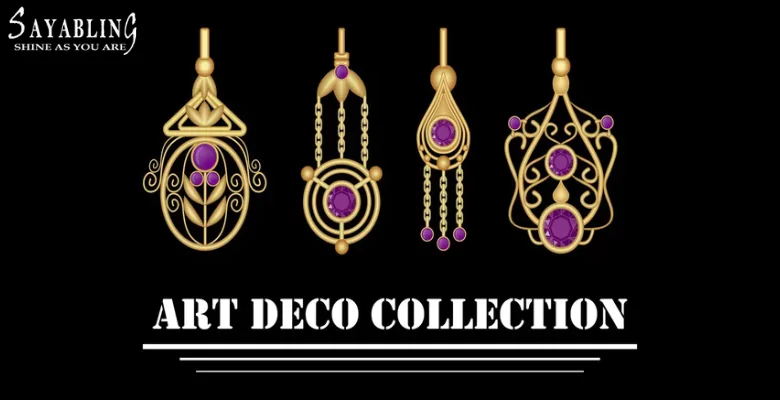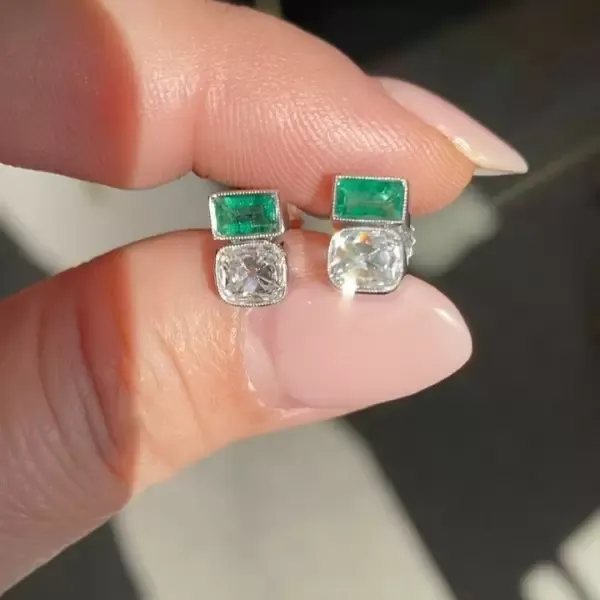A remarkable change from Edwardian to Art Deco jewelry stands out as one of history’s most captivating design transformations. These unique styles reflect the social attitudes, cultural values, and artistic priorities that defined the early 20th century. Collectors and enthusiasts who know how to spot Edwardian and Art Deco jewelry’s distinct characteristics can better appreciate each period’s unique beauty.
The jewelry design world saw distinctive elements emerge in both eras, from material choices and gemstone selections to patterns and motifs. Edwardian period’s pieces (1901-1915) showcase delicate, lace-like details with feminine designs. Art Deco jewelry (1920s-1930s) features bold geometric shapes and vibrant gemstones.
This piece highlights the essential differences between these influential periods by dissecting their historical context, design elements, and signature materials.
Historical Context: The Eras of Edwardian and Art Deco Jewelry
The Edwardian period (1901-1915) was the last jewelry era named after a British monarch. Europeans called it La Belle Époque, a time that celebrated refined and elegant jewelry design. This era saw a major change from machine-made pieces to handcrafted jewelry, and the “garland style” became its defining feature.
The Art Deco movement (1920s-1930s) broke away from earlier styles completely. This revolutionary style got its name from the 1925 Exposition Internationale des Arts Décoratifs in Paris and drew inspiration from various sources:
- Cubism and Futurism
- Egyptian art (after King Tutankhamun’s tomb discovery in 1922)
- Industrial design and modern architecture
World War I shaped the transition between these two distinct eras and brought jewelry production almost to a stop.
Jewelry in each of these eras was deeply influenced by the cultural shifts and technological advances of the time. The global conflict changed jewelry design dramatically:
| Pre-War (Edwardian) | Post-War (Art Deco) |
|---|---|
| Delicate filigree work | Bold geometric patterns |
| Romantic motifs | Industrial influences |
| Traditional techniques | Innovative methods |
The war changed more than just design aesthetics. Precious metals became hard to find, especially platinum which was needed to manufacture armaments. This shortage led to new jewelry-making techniques, including white gold’s introduction by New York jeweler David Belais in 1917.
New stone-cutting techniques emerged after the war. The diamond saw’s invention around 1910 and Marcel Tolkowsky’s 1919 publication “Diamond Design” changed gemstone cutting forever. These developments became the basis for the dramatic change from Edwardian’s delicate designs to Art Deco’s bold geometric patterns.
Design Elements: Comparing Edwardian and Art Deco Styles
Edwardian and Art Deco jewelry designs stand in sharp contrast to each other and reflect the radical changes in society and artistic expression of the early 20th century. These unique styles demonstrate vastly different approaches that shaped jewelry craftsmanship and esthetic sensibilities.
Edwardian: Delicate and feminine designs
Edwardian jewelry represents refined elegance through its incredibly intricate craftsmanship. These pieces showcase delicate openwork and lace-like patterns that create an ethereal appearance. The era’s master jewelers employed platinum’s strength to craft impossibly fine metal threads and tiny decorative beads. This signature milgrain technique gave each piece its soft, romantic character.
The “garland style” or style guirlande stands as the most distinctive characteristic of Edwardian design. This style incorporated:
- Flowing ribbons and bow motifs
- Delicate floral wreaths
- Intricate filigree work
- Gossamer-like metal details
Art Deco: Bold geometric patterns
Art Deco jewelry stands in sharp contrast to Edwardian delicacy and features bold architectural elements and precise geometric forms. This revolutionary style captured the essence of the machine age through:
| Design Element | Characteristics |
|---|---|
| Lines | Sharp, clean, and decisive |
| Shapes | Squares, triangles, and rectangles |
| Patterns | Symmetrical and streamlined |
| Overall Effect | Modern and sophisticated |
Differences in motifs and inspiration
These two styles drew inspiration from vastly different sources that reflected in their final appearances. Edwardian designs found their roots in 18th-century romanticism and featured natural elements with classical motifs. The pieces showcased garlands, bows, and laurel wreaths that created an atmosphere of refined nobility.
Art Deco jewelry took a different path and looked toward the future instead of the past. Its design elements drew influence from:
- Cubist art movements
- Industrial progress and machinery
- Ancient Egyptian and Asian cultures
- Modern architecture
This evolution from Edwardian to Art Deco styles signified more than just an aesthetic change. A new perspective on ornamentation emerged in society. Edwardian pieces celebrated traditional craftsmanship through intricate details, and Art Deco adopted modernity through clean lines and bold statements. These approaches created two distinct interpretations of luxury and beauty in jewelry design.
Materials and Gemstones: Signature Choices of Each Era
Materials and gemstones distinguish Edwardian jewelry from Art Deco pieces. These elements showcase the significant changes in artistic priorities and technological capabilities between the two eras.
Edwardian: Platinum, diamonds, and pearls
Platinum became the lifeblood of Edwardian jewelry craftsmanship. Its exceptional strength and malleability revolutionized design possibilities. Skilled jewelers crafted incredibly delicate pieces that resembled fine lace because of this precious metal’s unique properties.
Pearls commanded higher value than diamonds at the time and became the ultimate status symbol among society’s elite. The era’s pastel fashion palette paired perfectly with platinum settings that combined pearls and diamonds to create the signature “white-on-white” esthetic.
Art Deco: White gold, colored gemstones, and diamonds
Art Deco brought major changes to jewelry makers’ priorities. Platinum stayed popular, but everything changed when David Belais introduced white gold in 1917. This new material offered an affordable option that matched platinum’s beauty. The era’s palette became more adventurous and included gemstones that were once considered unfashionable:
| Traditional Gems | Novel Additions |
| Diamonds | Aquamarine |
| Sapphires | Jade |
| Rubies | Coral |
| Emeralds | Black Onyx |
Synthetic gemstones gained popularity during this time. Synthetic sapphires were especially valued because they offered perfect clarity and consistent color.
The rise of gemstone cuts and settings
New cutting techniques revolutionized jewelry design during these periods. The Art Deco era especially benefited when advanced cutting methods produced:
Innovative shapes to create dramatic effects:
- Trapezoids
- Half-moons
- Triangular cuts
- Baguette cuts
Cultured pearls became accessible to more people thanks to advances in pearl farming, making them the signature gem of the 1920s. The era brought popularity to invisible settings where stones naturally merged together and created mosaic-like patterns that defined Art Deco design.
Designers started using new materials like camphor glass that was treated with acid to create a frosted finish. This material paired beautifully with filigree work and diamond accents to create striking contrasts. Chromium plating emerged as a tarnish-resistant alternative to expensive metals.
The shift from Edwardian to Art Deco materials shows how society changed during this time. Edwardian jewelry showcased precious materials through delicate, sophisticated designs. Art Deco adopted both new techniques and accessibility by using innovative materials that would shape jewelry design for decades.
Edwardian vs. Art Deco Jewelry: Key Differences and Characteristics
Here’s the table that provides a concise overview of key differences between Edwardian and Art Deco jewelry.
Conclusion:
A remarkable design transformation took place in early 20th century jewelry as styles changed from Edwardian to Art Deco. Edwardian jewelry’s refined elegance shines through platinum filigree work, delicate pearls, and romantic motifs. Art Deco pieces welcome modernity with bold geometric patterns, varied gemstones, and architectural influences.
These styles perfectly mirror their eras – Edwardian pieces capture La Belle Époque’s grace, while Art Deco reflects the breakthroughs and social changes that followed World War I. These two periods have shaped jewelry design permanently and set lasting standards for craftsmanship and artistic expression. Edwardian pieces showcase traditional metalwork at its finest, creating ethereal beauty that collectors still prize today.
Art Deco’s groundbreaking design approach combines clean lines with striking color combinations. Modern jewelry makers continue to draw inspiration from both these remarkable artistic movements, proving their enduring appeal.
FAQ’s
Q.1: What distinguishes Edwardian jewelry from Art Deco jewelry?
Edwardian jewelry is influenced by Victorian styles, characterized by traditional cuts and a delicate appearance. In contrast, Art Deco jewelry draws inspiration from modern art and industrial themes, featuring precise and geometric stone cuts.
Q.2: How can one identify Edwardian jewelry?
Edwardian jewelry is known for its feminine, fluid, and fine designs. Typical features include hinges, dangles, swags, and small gemstone droplets that create a sense of movement and liveliness. Notably, Queen Alexandra was fond of the ‘dog collar’ style necklaces, which were fashionable yet uncomfortable, often lined with black velvet.
Q.3: What are the identifying features of Art Deco jewelry?
Art Deco jewelry is recognized for its linear and geometric shapes, often showcasing triangular patterns and iconic zigzag designs. These elements are combined to form bold borders that enhance the sparkle of the gems set within them.
Q.4: What are the typical characteristics of Art Deco jewelry?
Art Deco jewelry frequently includes designs inspired by the Machine Age, featuring streamlined forms and geometric patterns. Motifs that symbolize speed and progress, such as sunburst and skyscraper designs, are especially common in this style.

